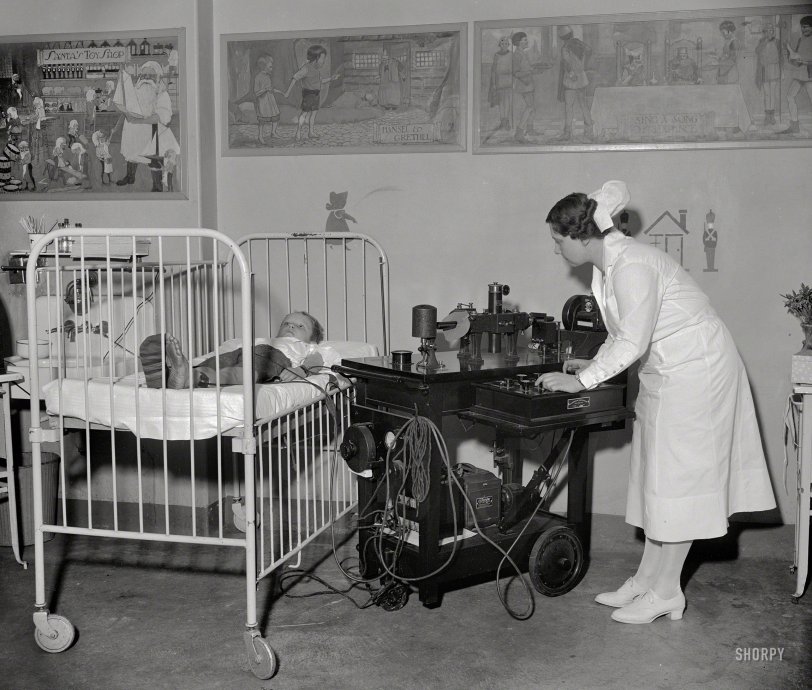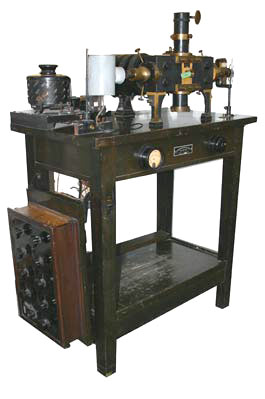


Framed or unframed, desk size to sofa size, printed by us in Arizona and Alabama since 2007. Explore now.
Shorpy is funded by you. Patreon contributors get an ad-free experience.
Learn more.

- Tough Guys
- Lost in Toyland
- And without gloves
- If I were a blindfolded time traveler
- Smoke Consumer Also Cooks
- Oh that stove!
- Possibly still there?
- What?!?
- $100 Reward
- Freeze Frame
- Texas Flyer wanted
- Just a Year Too Soon
- WWII -- Replacing men with women at the railroad crossing.
- Yes, Icing
- You kids drive me nuts!
- NOT An Easy Job
- I wonder
- Just add window boxes
- Icing Platform?
- Indiana Harbor Belt abides
- Freezing haze
- Corrections (for those who care)
- C&NW at Nelson
- Fallen Flags
- A dangerous job made worse
- Water Stop
- Passenger trains have right of way over freights?
- Coal
- Never ceases to amaze me.
- Still chuggin' (in model form)
Print Emporium
Jump-Start: 1937

Washington, D.C., circa 1937. "Children's Hospital Rotary." The young man hooked up to a Cambridge Instrument Model X900 Thingamambob. Medical technology experts please weigh in. Harris & Ewing glassneg. View full size.
Early attempt
The stories painted on the walls are an early attempt to make the hospital more welcoming to its young charges. Modern children's hospitals do this much better, with playgrounds, giant murals, and other touches that make them less terrifying for patients and parents. Not using the Cambridge Electrocardiograph also helps with that.
Maintenance
My field is equipment maintenance. The first thing I noticed was the tattered looking cord on the floor. It looks like it's been run over many times. I would be changing that out asap as a safety hazard.
Creepy murals
Pretty sure those creepy murals aren't sweetening the deal for that young fellow.
Its an ECG
Long time viewer, first time poster. The device is an ECG that utilized Willem Einthoven's principle of detecting electrical currents produced by the heart. His early system only used three electrodes. Wikipedia has an entry that includes a nice picture that closely resembles the device in your picture.
Early model
Early version of the machine that goes "ping."
A vintage ECG machine
To this retired cardiologist and medical history buff, this is easily recognizable as an early ECG machine. The equipment is based on a string galvanometer that vibrates sort of in tune to the heart's electrical activity. The string in this apparatus was photographed through a light and its vibrations recorded as the familiar waves on a photographic plate. These were in turn recorded, cut out and pasted on a piece of cardboard. Before the 1930s there were only 3 leads (to the limbs, as here) that were used. After that another three, called augmented leads, were devised, recorded with the same wiring. Then later on came the chest leads that some posters here commented on. And yes, I'd guess this boy might have had a brush with rheumatic fever.
Whatever it is
it puts out enough voltage to knock your sock off.
Don't think it's an electrocardiograph.
Yes the machine is similar to the Cambridge electrograph pictured in the submission by vintagetvs, but there are no electrode leads attached to the chest area which would be absolutely required for an EKG, nor does it appear there are enough unused leads for that purpose. The two visible leads are at the wrist and ankle, typical spots to detect the radial and tibial pulse, which causes me to guess that this instrument is designed to detect, monitor, record and/or amplify pulse rate and strength, which is often difficult to detect in children.
[These were the standard electrode positions until precordial leads were established as standard in 1938. -tterrace]
I stand corrected. Gary Hoff's explanation leaves no doubt as to what the instrument is. Many thanks!
This won't hurt a bit
This Shorpy post from 2009 looks like the same setup.
Early EKG
The boy is having an electrocardiogram. He probably had a run-in with rheumatic fever and has developed heart trouble as a result.
Universal Nightmare Generator
The murals on the wall were clearly created by someone under that machine's influence.
Electrocardiography
Cambridge Scientific was an early developer of the EKG machine. Prior to 1920, patients had to sit, with one hand and their feet, in buckets of salt water. Later, the contact electrode was invented and the buckets of water were used to mop the floors. There are just three leads connected to the patient in the photo. None seem to go to the chest area as do modern EKGs. Still, my money is on EKG machine.
Obviously
This is Nurse Frankenstein carrying on the family business.

























On Shorpy:
Today’s Top 5